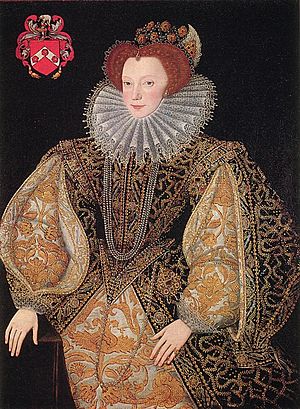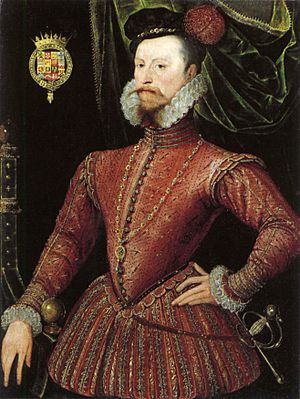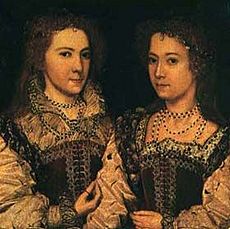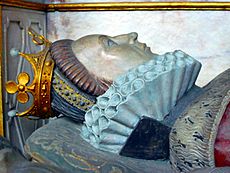Lettice Knollys facts for kids
Quick facts for kids
Lettice Knollys
|
|
|---|---|

Lettice Knollys as Countess of Leicester, c. 1585 by George Gower
|
|
| Born | 8 November 1543 Rotherfield Greys, Oxfordshire, England
|
| Died | 25 December 1634 (aged 91) Drayton Bassett, Staffordshire, England
|
| Resting place | The Beauchamp Chapel of the Collegiate Church of St Mary, Warwick, Warwickshire, England |
| Title | Viscountess Hereford Countess of Essex Countess of Leicester |
| Spouse(s) | Walter Devereux, 1st Earl of Essex Robert Dudley, 1st Earl of Leicester Christopher Blount |
| Children | Penelope Rich Dorothy Percy, Countess of Northumberland Robert Devereux, 2nd Earl of Essex Walter Devereux Francis Devereux Robert Dudley, Lord Denbigh |
| Parent(s) | Sir Francis Knollys Catherine Carey |
Lettice Knollys (pronounced NOHLZ) was an important English noblewoman who lived a long life from 1543 to 1634. She was known as the Countess of Essex and later the Countess of Leicester. Lettice was the mother of two famous people at court: Robert Devereux, 2nd Earl of Essex, and Lady Penelope Rich. Her second marriage was to Robert Dudley, Earl of Leicester, who was a close friend of Elizabeth I. This marriage made Queen Elizabeth I very unhappy.
Lettice Knollys was a grandniece of Queen Elizabeth's mother, Anne Boleyn. Because of this family connection, Lettice was close to Elizabeth since childhood. She was introduced to life at the royal court early on. At 17, she married Walter Devereux, who later became the Earl of Essex in 1572.
After her first husband died in 1576, Lettice Knollys secretly married Robert Dudley two years later. When Queen Elizabeth found out, she was very angry. The Queen banished Lettice from court forever, which meant she could no longer attend royal events. Lettice and Robert Dudley had a son named Robert, Lord Denbigh, but he sadly died at age three. Despite the Queen's anger, Lettice's marriage to Robert Dudley was a happy one.
After Dudley's death, Lettice married Sir Christopher Blount in 1589. He was much younger than her. She continued to be known as Lady Leicester. She was left wealthy by Dudley's will, but she had to use much of her money to pay off his large debts.
In the early 1600s, Lettice had to go to court to protect her rights. This happened when Robert Dudley, who claimed to be her late husband's legitimate son, tried to take her property. Lettice won the case and kept her good name. She was always close to her large family. She faced great sadness when both her eldest son, the Earl of Essex, and her third husband were executed in 1601. From the 1590s, she mostly lived in the countryside. She remained healthy until the end, dying at 91 on Christmas Day in 1634.
Contents
Early Life and Family Connections
Lettice Knollys was born on November 8, 1543, in Rotherfield Greys, Oxfordshire. Her father, Sir Francis Knollys, was a Member of Parliament. He also worked for Prince Edward. Her mother, Catherine Carey, was the daughter of Mary Boleyn. Mary Boleyn was the sister of Anne Boleyn, Queen Elizabeth I's mother. This made Catherine Carey Queen Elizabeth's first cousin. So, Lettice Knollys was Queen Elizabeth's first cousin once removed. Lettice was the third of her parents' 16 children.
Her parents were Protestants. In 1556, they went to Germany to avoid religious persecution under Queen Mary I. They took five of their children with them. It is not known if Lettice was among them. She might have spent these years living with Princess Elizabeth. Her family had been close to Elizabeth since the mid-1540s.
Her parents and the rest of the family returned to England in January 1559. This was two months after Elizabeth I became Queen. Sir Francis Knollys was made Vice-Chamberlain of the Royal Household. Lady Knollys became a senior Lady of the Bedchamber. Lettice became a Maid of the Privy Chamber, serving the Queen.
First Marriage and Court Life

In late 1560, Lettice Knollys married Walter Devereux. He was known as Viscount Hereford. The couple lived at their family home, Chartley Castle in Staffordshire. Their first two daughters, Penelope and Dorothy, were born there in 1563 and 1564.
Lettice Devereux returned to court in the summer of 1565. The Spanish ambassador described her as "one of the best-looking ladies of the court." He also said she was a favorite of the Queen. While pregnant with her first son, she was seen flirting with Robert Dudley, Earl of Leicester. He was the Queen's favorite. The Queen quickly found out and became very jealous.
Lettice returned to Staffordshire. In November 1565, she gave birth to Robert, who later became the 2nd Earl of Essex. She had two more sons after him: Walter, born in 1569, and Francis, who died soon after birth.
Walter Devereux became the Earl of Essex in 1572. In 1573, he suggested to the Queen a plan to settle Englishmen in Ulster, Ireland. He went to Ireland that autumn and did not return for two years. During this time, Lettice may have become close to the Earl of Leicester. In 1573, Leicester sent her a gift of venison from his home, Kenilworth Castle. She also visited Kenilworth for hunting in 1574 and 1576. She was present in July 1575 when Dudley hosted a grand 19-day festival for the Queen at the castle. Elizabeth and her court then visited Chartley, where the Countess of Essex welcomed them.
The Earl of Essex returned to Ireland in July 1576. He died in Dublin on September 22 from a disease called dysentery. There were rumors that Leicester had poisoned him, but an official investigation found that Essex died of natural causes. His body was brought to Carmarthen, where his widow attended the funeral.
After her husband's death, Lettice's inheritance was not enough for her and her children. She partly lived at her father's house. She also stayed with friends. She asked for more money from the authorities. After seven months, she reached a better agreement. She said she was "content to respect my children more than myself." She also tried to get the Queen to forgive Essex's debts to the Crown. These debts were a heavy burden on her son's inheritance.
Marriage to Leicester and Royal Displeasure

Lettice Knollys married Robert Dudley, Earl of Leicester, on September 21, 1578. The wedding was very private, held at his country house, Wanstead Hall in Essex. Only six other people were there, including her father and brother. The marriage happened almost a year after Leicester and his guests had planned it. The date also marked the end of the usual two-year mourning period for a widow.
Leicester had been a widower since 1560. For many years, he had hoped to marry Queen Elizabeth herself. He feared Elizabeth's reaction to his marriage, so he wanted it to be a secret. However, the secret did not last long. The French ambassador reported it two months later. When the Queen was told about the marriage the next year, she permanently banished Lettice Dudley from court. Elizabeth never forgave her cousin and never accepted the marriage. Even when Lady Leicester traveled through London, the Queen was upset.
For several years after her new marriage, Lettice Dudley continued to call herself Countess of Essex. She lived very quietly, often with her relatives at the Knollys family home. In February 1580, she was expecting a child there. For the birth of Leicester's heir, Robert, Lord Denbigh, in June 1581, she moved to Leicester House in London.
In 1583, Lettice Dudley officially moved into Leicester House. Queen Elizabeth was once again furious with the Earl about his marriage. A few weeks later, the French ambassador visited Leicester's grand house. He noted that Leicester's wife had "much influence over him."
Robert Dudley had been close to the Knollys family since the 1550s. Several of Lettice's brothers had worked for him. His marriage made his relationship with her siblings even stronger. He was a caring and generous stepfather to her four children. Lettice Dudley paid for her personal expenses and servants using money from her first husband's will. She remained mostly excluded from society life due to the Queen's displeasure.
Sadly, the three-year-old Lord Denbigh died suddenly on July 19, 1584. His death ended the hopes of a family line for the House of Dudley. Leicester stayed away from court for a few weeks to comfort his "sorrowful wife." He also thanked Lord Burghley for trying to help his wife with the Queen.
In 1585, Leicester led an English army to help the United Provinces against Spain. He made Elizabeth angry when he accepted the title of Governor-General in January 1586. What especially angered her was a rumor that the Countess of Leicester planned to follow her husband to the Netherlands. The rumor said she would bring many ladies and grand coaches, making her court grander than the Queen's. This information was false.
The Earl returned to England in December 1586. He was sent to the Netherlands again in June 1587, which saddened his wife. Leicester finally left his post in December 1587. The Countess was with him when he died unexpectedly on September 4, 1588. He may have died of malaria. They had been traveling to Kenilworth. The Earl's funeral was held in Warwick in October 1588. His widow and many family members attended.
Later Life and Challenges

Lettice Dudley became a wealthy widow. Leicester's will named her as the person in charge of his estate. Her income from both her husbands' wills was about £3,000 each year. She also received valuable items worth £6,000. However, she had to use much of her money to pay off Leicester's huge debts, which were around £50,000.
In March or April 1589, just six months after Leicester's death, Lettice married Sir Christopher Blount. He was a Catholic soldier, 12 years younger than her, and had been a trusted friend of the Earl of Leicester. This marriage was a big surprise. Her son, the Earl of Essex, complained that it was an "unhappy choice." Lettice explained her choice by saying she was a defenseless widow. Like her marriage to Leicester, this union also proved to be a happy one.
Lettice's second son, Walter Devereux, died in 1591 while on military duty in France. In the following years, she worried about her eldest son, Robert. She called him "Sweet Robin" and longed for his letters. In 1593, she sold Leicester House to him, and it became known as Essex House. She moved to Drayton Bassett in Staffordshire. This became her main home for the rest of her life.
Still banned from court, she saw no reason to return to London without making peace with Queen Elizabeth. In December 1597, she heard that the Queen might be willing to reconcile. She prepared for a "winter journey" if her son thought it would help. "Otherwise a country life is fittest for disgraced persons," she said. She traveled to London and stayed at Essex House from January to March 1598. She hoped to reconcile with Elizabeth. Finally, a short meeting was granted. The Countess kissed the Queen, and "the Queen kissed her," but nothing truly changed.
Her son, the Earl of Essex, was imprisoned in 1599 after returning from Ireland without permission. His mother came to London to speak to the Queen for him. She tried to send Elizabeth a gift, a gown, but the Queen did not accept it. Her attempts to see her son made things worse. During Essex's rebellion, trial, and execution in February 1601, Lettice stayed at Drayton Basset. This was a terrible personal disaster for her. She lost not only her son but also her beloved third husband, Sir Christopher Blount. He was executed on March 18, 1601, three weeks after his stepson. Sir Christopher had been a close friend to Robert Devereux for many years.
Legal Battles and Final Years
The executions of Essex and Blount led to legal arguments over the Countess of Leicester's remaining property. She claimed that Blount had used her jewels and much of her land to pay off Leicester's debts. When Queen Elizabeth I died in 1603, things improved for the Countess. The new king, James I, not only gave her grandson, the third Earl of Essex, his father's title and property back. He also canceled her remaining debts to the Crown, which were almost £4,000.
Even more than his debts, the Earl of Leicester's will caused legal problems. He had intended for his son, Robert Dudley, to inherit Kenilworth Castle after his brother's death. Some of the Countess's lands were near the castle. These lands had been given to the younger Robert Dudley in Leicester's will. After Leicester's brother died in 1590, long legal battles began over whether certain parts of Lady Leicester's property belonged to the Kenilworth estate.
In 1603, Robert Dudley tried to prove that he was the legitimate son of his parents. If he succeeded, it would mean that Lettice Knollys's marriage to Leicester was not valid. It would also cancel her rights to her inheritance.
Because of this, in February 1604, she filed a complaint against Dudley in the Star Chamber, a special court. She accused him of harming her reputation. She was supported by Sir Robert Sidney, who believed he was the only rightful heir. During the court case, 56 former servants and friends of the Earl of Leicester testified. They all said that he had always considered Dudley to be his son born outside of marriage. The other side could not provide clear evidence. The King's chief minister decided it was best not to change the existing property agreement. So, the outcome was in favor of Lady Leicester. All the evidence was sealed to prevent the case from being reopened.
Throughout her life, Lettice Knollys cared for her siblings, children, and grandchildren. Her daughters Penelope and Dorothy were her closest companions until their deaths. Her grandson, the young third Earl of Essex, spent much of his life with the old Countess at Chartley and Drayton Bassett.
Lettice Knollys was still walking a mile a day when she was nearly 90 years old. She died in her chair on Christmas Day, December 25, 1634, at the age of 91. Many people mourned her as a symbol of an earlier time. She wished to be buried "at Warwick by my dear lord and husband the Earl of Leicester." Her wish was honored. She was laid to rest in the Beauchamp Chapel of Collegiate Church of St Mary, Warwick. Her tomb is opposite the tomb of her son, young Lord Denbigh.
Descendants
An episode of the TV show Who Do You Think You Are? showed that British comedian Josh Widdicombe is a direct descendant of Lettice Knollys.
See also
 In Spanish: Lettice Knollys para niños
In Spanish: Lettice Knollys para niños
- Cultural depictions of Elizabeth I of England
|



